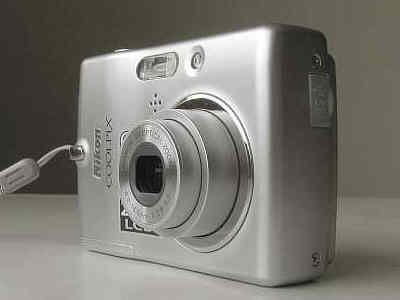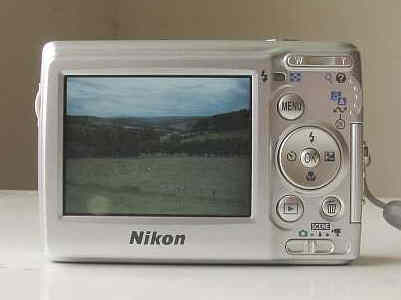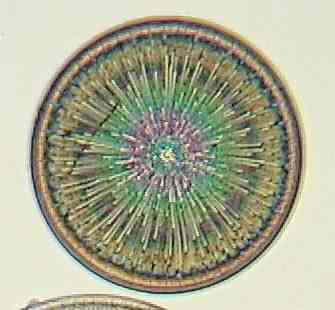 |
 |
| Photomicrography With Cheap
Contemporary Digicams A very brief peep at Sub £50 digicam success over the eyepiece for the novice By Paul James |
I recently had the chance to evaluate the physically small 6.0 megapixel Nikon L10/11 digicam which was bought at the base price of £49.00 in the UK. It fits comfortably into the proverbial top pocket, is light and very responsive with image quality being rather better than I had anticipated though it cannot compete with 6 megapixel DSLRs of course. The first digicam I owned : The Olympus C830L which I first used to illustrate my initial articles at Micscape had a 1.3 megapixel CCD sensor and the shutter delay was decidedly sluggish at around 1/2 second. Yet it cost £300 : a discounted price then! So the Nikon L11 is significantly less than a 1/6 of this figure when inflation is taken into consideration, with a leap in image quality and handling efficiency.
The Nikon L 11 sports a x3 zoom which allows its small diameter, lowish aperture lens to capture the most favourable part of the eyepiece's emerging image for photomicroscopy. Most eyepieces, and more especially high eyepoint forms easily fill the 6 megapixel CCD with the whole field or part thereof by appropriate adjustment of the zoom. Supporting the body of the camera is the only operation requiring careful thought, and can take a variety of forms using simple steadied hand support stands to more permanent tailor made configurations. The trick is to realise the camera lens's exact placement over the eyepiece to capture the full field, whilst allowing the zoom to maneouvre through its range without causing harm by physical contact with the eyepiece or mount.
 |
 |
The chromed lens boundary ring shown above is shallow and cannot be used for attachment other than to provide a registration into a similarly shallow circular rebate in the upper end of a tube used to fit over the eyepiece. Since the Nikon L 11 only has delayed action shutter release and no infra red remote control, capturing images over the eyepiece is confined to the former.
Contemporary digicam facilities are provided such as a largish lcd screen and a basic but adequate menu system commensurate with a cheap point and shoot digicam. There's no manual override, just auto mode and some scene modes, but the facility of being able to quench the autoflash feature is fortunately easily implemented. The lcd screen is large enough and the rear finger controls are naturally intuitive in use. The x3 zoom is very fast in action, in fact too fast, but by just 'morse coding' the zoom lever rather than pressing it enables more incremental control.
The images below show a capable camera considering its price.
 |
This crop above
comes from the original 2816 x 2112 image after resampling down
to 1024 x 768 revealing a reasonable representation
of a blow
fly's tongue.
 |
The untouched crop below from the was taken from this resampled downsized image above for illustration and shows the pixel for pixel quality of the camera's lens/CCD combination. It seems clearly evident that both the camera lens and CCD are doing their jobs well.
 |
Concluding Thoughts
Times have changed since the first consumer digicams flooded the world markets with sub one megapixel models. Now there are few below the 6 megapixel mark, most sporting larger CCD's, though whether this is necessarily a requirement of good image making is debatable. Certainly for onscreen use cameras like this Nikon L11 are more than adequate for general photomicroscopy, and no doubt modest printed usage too. As nearly always the real problem isn't the camera's imaging capability that's in question, but the required ingenuity of making a suitable mounting for the camera over the eyepiece. There are a number of articles in Micscape's library which cover this subject with different cameras. The principles of this tricky venture have not changed since the first digicams appeared, still demanding a lot of thought, and handiwork too of course.
As for this particular camera : The Nikon L11 .........its only 'flaws' appear to be the minute presence of chromatic aberrations from the lens, and its wavering white colour balance, both commonly experienced characteristics of digicams in even some of the top end models no less. I'd prefer the body to be more easily gripped as it is it slips too easily from the fingers but for the safety strap......I think that's its principle fault, despite this it is a very capable performer for the money.
| All comments welcome by the author Paul James |
Microscopy UK Front Page
Micscape
Magazine
Article
Library
Please report any Web problems or offer general comments to the Micscape Editor.
Micscape is the on-line monthly
magazine of the Microscopy UK web
site at
Microscopy-UK